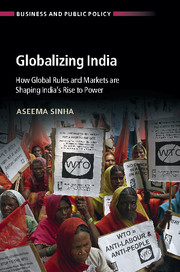Book contents
- Frontmatter
- Dedication
- Contents
- List of figures
- List of tables
- Preface and acknowledgments
- Note on currency translation
- List of abbreviations
- 1 How global rules and markets are shaping India's rise to power
- 2 A theory of causal mechanisms and Global Design-in-Motion
- 3 Trade, statecraft, and state capacity in India
- 4 Realigning interests toward global reach: Changes in India's pharmaceutical sector
- 5 Mobilizing new interests and tying the state's hands: Decline and revival in the textile sector
- 6 Interests in motion: Private sector change in India's textile sector
- 7 Mechanisms of change within global markets
- 8 Conclusion
- Appendix: Field trips, and list of interviews, and libraries visited
- References
- Index
1 - How global rules and markets are shaping India's rise to power
Published online by Cambridge University Press: 05 April 2016
- Frontmatter
- Dedication
- Contents
- List of figures
- List of tables
- Preface and acknowledgments
- Note on currency translation
- List of abbreviations
- 1 How global rules and markets are shaping India's rise to power
- 2 A theory of causal mechanisms and Global Design-in-Motion
- 3 Trade, statecraft, and state capacity in India
- 4 Realigning interests toward global reach: Changes in India's pharmaceutical sector
- 5 Mobilizing new interests and tying the state's hands: Decline and revival in the textile sector
- 6 Interests in motion: Private sector change in India's textile sector
- 7 Mechanisms of change within global markets
- 8 Conclusion
- Appendix: Field trips, and list of interviews, and libraries visited
- References
- Index
Summary
“Self Reliance Means Trade, Not Aid”
Manmohan SinghThat India marches to its own tune in world politics “is a familiar platitude that happens to be true.” For much of its history, India has acted as a “reclusive porcupine,” slow-footed, defensive, and prickly in its interactions with the global world. It has shown a remarkable ability to resist global pressures and integration imperatives. Many scholars and policymakers would concur with Joseph M. Grieco, who said: “India possesses [in the 1970s] one of the world's most restrictive, cumbersome, and ‘assertive’ regimes regulating foreign direct investments” (Grieco 1984, 16). Consequently, India's export share of world trade declined from 2.42 percent in 1948 to 0.41 percent in 1979; this was at a time when the newly industrializing countries in East Asia (Japan and South Korea, for example) were increasing their world market penetration (Wolf 1982, 18). As late as 1991, India's commerce minister, the Harvard-trained Dr. Subramanian Swamy, said: “India does not need GATT [the General Agreement on Trade and Tariffs, a global trade agreement] because of its large size.” By 1991, India's share of world trade was dismally low, a mere 0.51 percent (Gangopadhyay 1998, 46). This insular attitude was mirrored in a self-driven industrialization drive, “export pessimism” (Bhagwati and Srinivasan 1984), and suspicion of global alliances. India's embrace of economic reforms and global integration occurred much later, starting only in the 1990s, by which time other countries – China, Chile, Brazil, and Mexico, for example – had already implemented numerous reforms (Draper, Alves, and Sally 2009). This delay continues to haunt the trajectory of India's reforms, manifesting in a weakness of the Indian currency and a lack of foreign investment as well as key weaknesses in infrastructural development.
Despite this delayed start and intermittent crises, many Indian actors have embraced globalization and transformed India into a more open economy and an active participant in global alliances, all in a remarkably short span of time. In 2005 Manmohan Singh, India's prime minister, declared: “Being an open democratic polity and an open economy empowers India.”
- Type
- Chapter
- Information
- Globalizing IndiaHow Global Rules and Markets are Shaping India's Rise to Power, pp. 1 - 29Publisher: Cambridge University PressPrint publication year: 2016

